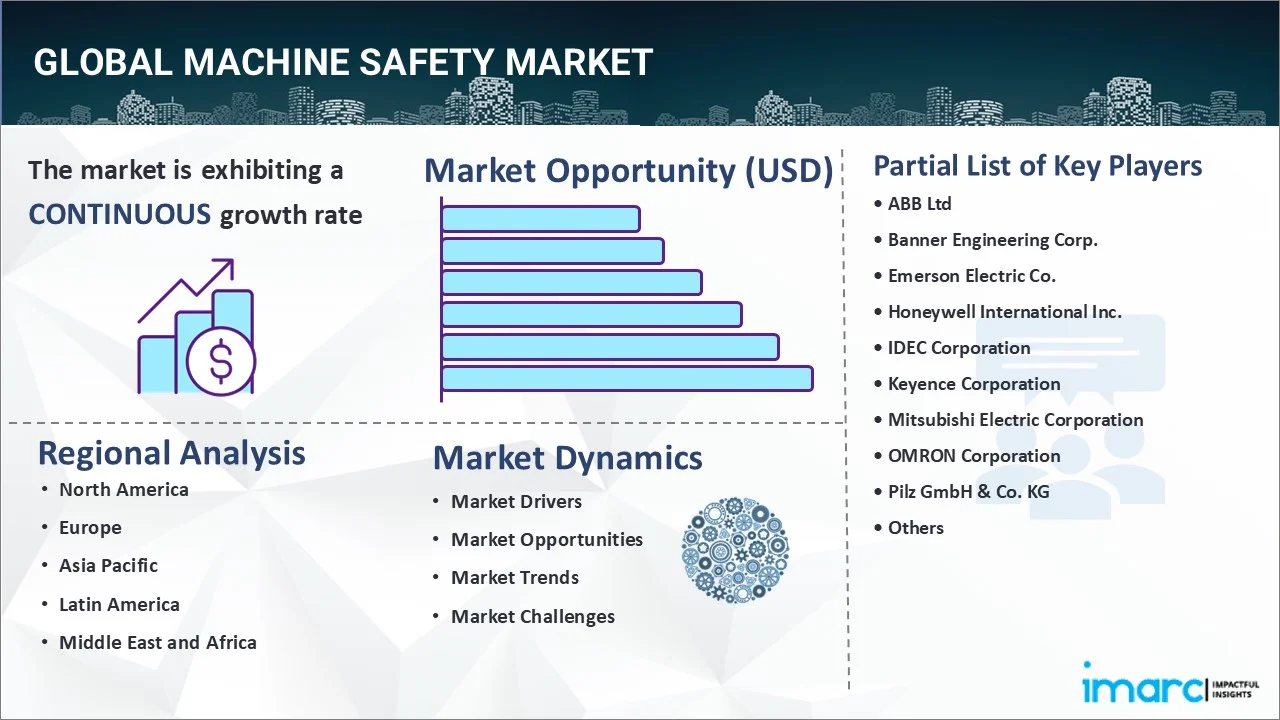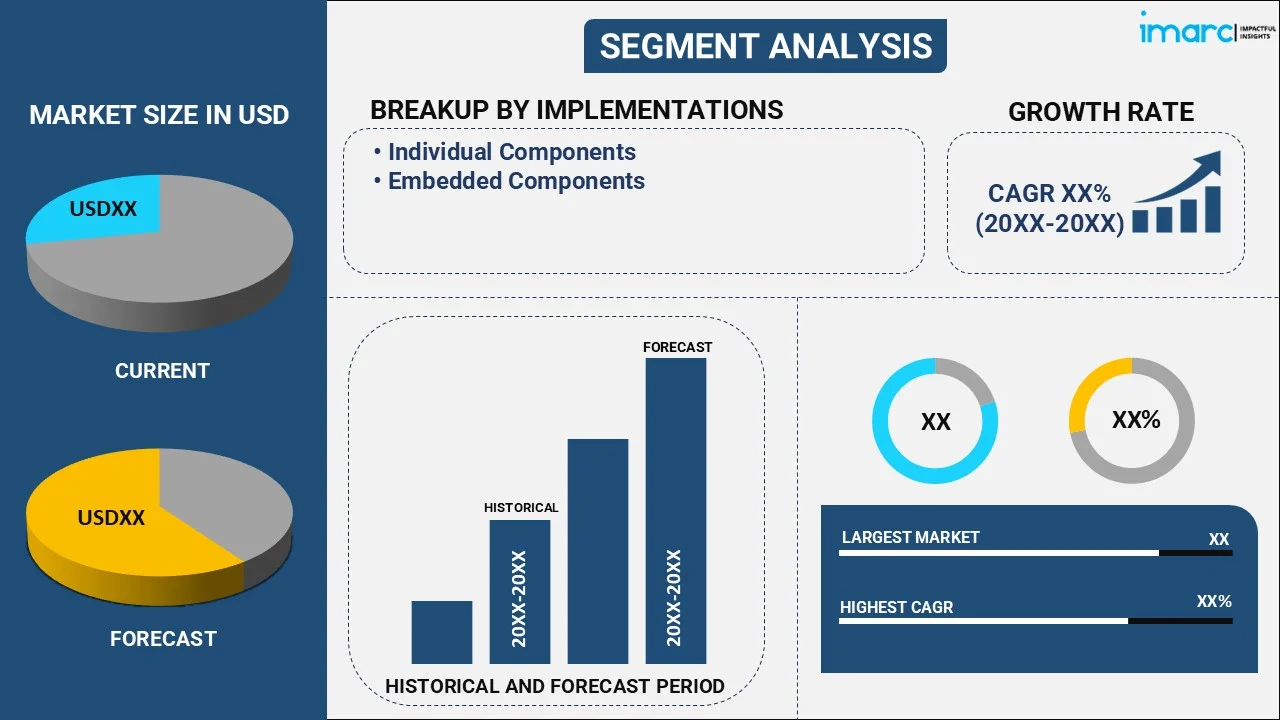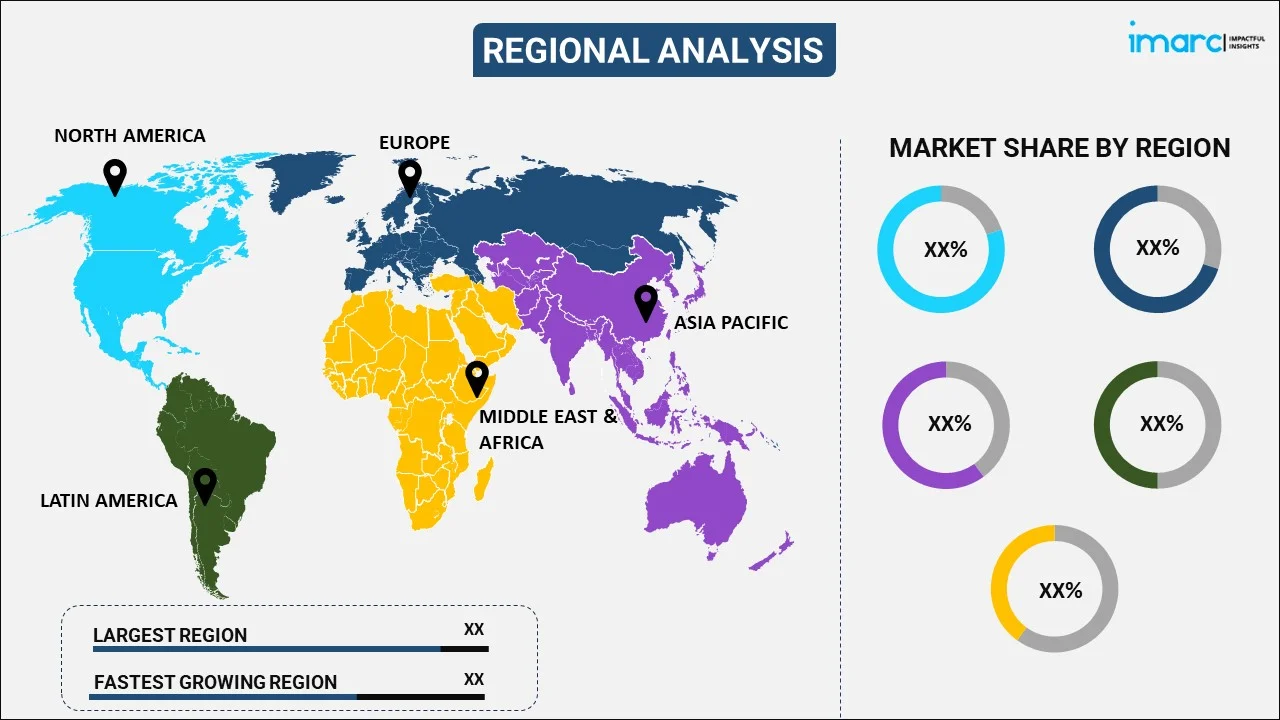
Machine Safety Market Report by Implementation (Individual Components, Embedded Components), Component (Presence Sensing Safety Sensors, Emergency Stop Devices, Safety Interlock Switches, Safety Controller/Modules/Relays, and Others), End Use Industry (Automotive, Electronics and Semiconductors, Food and Beverages, Healthcare and Pharmaceuticals, Metals and Mining, Oil and Gas, and Others), and Region 2025-2033
Market Overview:
The global machine safety market size reached USD 5.8 Billion in 2024. Looking forward, IMARC Group expects the market to reach USD 9.4 Billion by 2033, exhibiting a growth rate (CAGR) of 5.19% during 2025-2033. The rise in automation and industrial upgradation, the implementation of stringent regulatory frameworks mandating the use of machine safety, and the ongoing product innovation and integration of IoT technologies are some of the major factors propelling the market.
|
Report Attribute
|
Key Statistics
|
|---|---|
|
Base Year
|
2024 |
|
Forecast Years
|
2025-2033 |
|
Historical Years
|
2019-2024
|
|
Market Size in 2024
|
USD 5.8 Billion |
|
Market Forecast in 2033
|
USD 9.4 Billion |
| Market Growth Rate 2025-2033 | 5.19% |
Machine safety encompasses different mechanisms and precautions designed to guard both machines and those operating them. Emergency stop mechanisms, safety sensors, interlock switches, protective attire, safety curtain lights, presence sensors, safety controllers, relays, and modules are among the widely used safety tools. Their purpose is to negate potential dangers posed by moving machine parts, heated surfaces, or sharp edges, thereby preventing severe work-related accidents. Consequently, these safety systems are broadly employed across numerous sectors such as food and beverage (F&B), automotive, manufacturing, healthcare, electronics, semiconductors, power generation, and oil and gas.

The surging focus on safety in the industrial sector, coupled with the rise in workplace accidents, is one of the key factors driving the market growth. Besides this, numerous governments across the world, alongside global organizations such as the International Organization for Standardization (ISO) and the International Electrotechnical Commission (IEC), are implementing strict machinery safety standards and mandates, further creating a favorable outlook for market expansion. Moreover, an influx of investments dedicated to modernizing existing machinery to boost production capacity, coupled with rising demand for industrial automation products, is presenting remunerative growth opportunities for the market. Furthermore, ongoing product advancements and innovations enhancing machine safety, efficiency, and reliability, the advent of Industry 4.0, the increasing awareness of workplace safety, and the wide-ranging application of the Internet of Things (IoT) solutions are contributing to the market growth.
Machine Safety Market Trends/Drivers
Increased industrial safety regulations
Heightened industrial safety regulations are playing a crucial role in driving the growth of the machine safety market. Regulatory bodies worldwide, including ISO and IEC, are introducing more stringent safety standards for machinery to curb the number of workplace accidents and safeguard employee welfare in industries, especially those involving the operation of heavy machinery. Industries are obligated to comply, which necessitates the deployment of effective machine safety measures and systems. This regulatory pressure leads to a surge in demand for machine safety products and solutions, creating a positive outlook for the market's growth. Moreover, failure to comply with these safety standards could result in significant legal and financial repercussions for industries, including substantial penalties and potential reputational damage. Consequently, this compels industries to invest more in machine safety solutions, further supporting the market growth.
Rising automation and industrial upgradation
The expanding automation and industrial upgradation are significantly impacting the expansion of the machine safety market. The growing need to protect workers and maintain operational efficiency in these modern industrial environments is aiding in market expansion. As industries increasingly incorporate automation into their operations to improve productivity and efficiency, there is a subsequent increase in the need for effective machine safety systems. Automated machinery, although highly efficient, can pose potential risks to human operators if not properly safeguarded. Machine safety devices serve to mitigate these risks and protect workers from potential accidents. Furthermore, industrial upgradation, which involves the modernization of existing machinery, is further impelling the demand for machine safety solutions. Industries invest in upgrading machinery not only to improve performance and production capacity but also to ensure compliance with safety standards. This often involves the installation of advanced safety devices and systems designed to protect both the machinery and its operators.
Influence of industry 4.0 and IoT
The advent of Industry 4.0 and the widespread adoption of the Internet of Things (IoT) are driving the growth of the machine safety market. The fourth industrial revolution, and the emerging trends of automation and data exchange in manufacturing technologies, bring with them a higher level of interconnectivity and automation. This leads to an increased need for machine safety measures to ensure that human operators can work safely alongside automated machinery. IoT-enabled safety systems can immediately detect irregularities or potential safety risks and initiate preventative actions, thereby reducing hazards and enhancing safety. Moreover, IoT allows for real-time monitoring and data collection from machinery that can be analyzed to predict machine failures, monitor machine health, and further improve safety measures. As a result, the integration of IoT in machine safety to enable more advanced, efficient, and reliable safety solutions is presenting remunerative growth opportunities for the market.
Machine Safety Industry Segmentation:
IMARC Group provides an analysis of the key trends in each segment of the global machine safety market report, along with forecasts at the global, regional and country levels from 2025-2033. Our report has categorized the market based on implementation, component and end use industry.
Breakup by Implementation:

- Individual Components
- Embedded Components
Embedded components are dominating the market
The report has provided a detailed breakup and analysis of the market based on the implementation. This includes individual and embedded components. According to the report, embedded components represented the largest segment.
The demand for embedded components in machine safety is being propelled by the rising complexity of machinery and equipment, creating a demand for more advanced and integrated safety solutions. Embedded components provide these sophisticated solutions, allowing for real-time monitoring, system control, and the prevention of potentially hazardous situations. In line with this, the emerging trends of miniaturization are also contributing to the demand as embedded components often have a smaller footprint compared to traditional safety equipment, making them more suitable for applications within compact spaces. Furthermore, the surging use of embedded components in machine safety systems to allow for more effective use of energy and lower their environmental impact and improve energy efficiency is propelling the market forward. Apart from this, embedded components often offer improved reliability and lifespan compared to traditional components, reducing the need for maintenance and replacement and providing long-term cost benefits for industries.
Breakup by Component:
- Presence Sensing Safety Sensors
- Emergency Stop Devices
- Safety Interlock Switches
- Safety Controller/Modules/Relays
- Others
Presence sensing safety sensors hold a larger share in the market
A detailed breakup and analysis of the market based on the component has also been provided in the report. This includes presence sensing safety sensors, emergency stop devices, safety interlock switches, safety controller/modules/relays, and others. According to the report, presence sensing safety sensors accounted for the largest market share.
The rising demand for presence-sensing safety sensors in machine safety on account of their ability to provide non-contact detection of workers near hazardous machinery is acting as a significant growth-inducing factor. Moreover, these sensors, capable of detecting a person's presence within a certain perimeter, can instantly initiate a stop command, preventing accidents. In line with this, the surge in industrial automation has intensified the need for these sensors as in automated environments where humans and machines coexist, presence-sensing safety sensors are indispensable for ensuring worker safety. They effectively reduce the risk of injuries from moving machinery or unexpected startups after maintenance. Lastly, advancements in sensor technology, including improved accuracy, reliability, and durability, have increased their adoption. In addition to this, the integration of IoT in these sensors allows for real-time monitoring and data analysis, thereby enhancing predictive maintenance and overall safety.
Breakup by End Use Industry:
- Automotive
- Electronics and Semiconductors
- Food and Beverages
- Healthcare and Pharmaceuticals
- Metals and Mining
- Oil and Gas
- Others
The report has provided a detailed breakup and analysis of the market based on the end use industry. This includes automotive, electronics and semiconductors, food and beverages, healthcare and pharmaceuticals, metals and mining, oil and gas, and others.
Machine safety solutions find extensive applications across the automotive sector to safeguard personnel during the assembly process, welding operations, and other automated manufacturing procedures. Advanced safety sensors ensure the immediate halt of machinery upon human contact, preventing accidents. Besides this, widespread product utilization in the electronics and semiconductors sector for protecting workers from electrical hazards, high-heat operations, and potential injuries from moving parts during chip manufacturing is contributing to the market growth. In confluence with this, machine safety also ensures operational continuity and worker safety, increasing overall productivity. Moreover, the increasing use of machine safety systems in the food and beverages (F&B) industry to safeguard workers against injuries from high-speed food processing and packaging equipment is acting as a crucial growth-inducing factor. Furthermore, surging product adoption across the healthcare and pharmaceutical industries during drug production and packaging processes to mitigate the risk of contamination and protect personnel from potential harm due to machinery malfunctions is propelling the market forward.
Breakup by Region:

- North America
- United States
- Canada
- Asia-Pacific
- China
- Japan
- India
- South Korea
- Australia
- Indonesia
- Others
- Europe
- Germany
- France
- United Kingdom
- Italy
- Spain
- Russia
- Others
- Latin America
- Brazil
- Mexico
- Others
- Middle East and Africa
The report has also provided a comprehensive analysis of all the major regional markets, which include North America (the United States and Canada); Europe (Germany, France, the United Kingdom, Italy, Spain, Russia, and others); Asia Pacific (China, Japan, India, South Korea, Australia, Indonesia, and others); Latin America (Brazil, Mexico, and others); and the Middle East and Africa.
The stringent regulatory framework in North America imposed by occupational safety authorities, such as OSHA (Occupational Safety and Health Administration), represents the key factor impelling the market growth. In addition to this, the expansion of automation across the automotive, manufacturing, and food & beverages industries is promoting the use of machine safety systems.
On the other hand, strict safety standards set by European Union (EU) regulations mandating the incorporation of safety measures in industrial settings are strengthening the market growth.
Apart from this, rapid industrialization and expansion of manufacturing activities in the Asia Pacific region, particularly in countries such as China, India, and South Korea, is presenting lucrative growth opportunities for the market. Furthermore, increasing awareness about workplace safety and the growing adoption of automation technologies in these regions are significantly contributing to the market growth.
Competitive Landscape:
The global machine safety market is characterized by intense competition, with numerous players vying for market share. The competitive landscape includes a mix of well-established multinational corporations and emerging players. Key competitors hold substantial market shares due to their expansive product portfolios, extensive geographical presence, and strong brand recognition. Many of these companies are investing heavily in R&D to innovate and improve their product offerings. They aim to develop advanced machine safety solutions that adhere to stringent safety standards and meet the diverse needs of various industries. In addition to this, strategic partnerships, mergers, acquisitions, and collaborations are common strategies employed by companies to broaden their market outreach and enhance their product lines.
The report has provided a comprehensive analysis of the competitive landscape in the market. Detailed profiles of all major companies have also been provided. Some of the key players in the market include:
- ABB Ltd
- Banner Engineering Corp.
- Emerson Electric Co.
- Honeywell International Inc
- IDEC Corporation
- Keyence Corporation
- Mitsubishi Electric Corporation
- Omron Corporation
- Pilz GmbH & Co. KG
- Rockwell Automation
- Schneider Electric
- Sick AG
- Siemens AG
Recent Developments:
- In July 2023, ABB and Microsoft announced their collaboration to bring generative AI to industrial digital solutions for safer, smarter, and more sustainable operations.
- In July 2023, Emerson announced that Cavendish Renewable Technology (CRT) will collaborate with Emerson’s automation and software portfolio to accelerate the deployment of CRT’s hydrogen production solutions.
- In July 2023, Honeywell announced the acquisition of SCADAfence, a leading provider of operational technology (OT) and Internet of Things (IoT) cybersecurity solutions for monitoring large-scale networks.
Machine Safety Market Report Scope:
| Report Features | Details |
|---|---|
| Base Year of the Analysis | 2024 |
| Historical Period | 2019-2024 |
| Forecast Period | 2025-2033 |
| Units | Billion USD |
| Scope of the Report | Exploration of Historical and Forecast Trends, Industry Catalysts and Challenges, Segment-Wise Historical and Predictive Market Assessment:
|
| Implementations Covered | Individual Components, Embedded Components |
| Components Covered | Presence Sensing Safety Sensors, Emergency Stop Devices, Safety Interlock Switches, Safety Controller/Modules/Relays, Others |
| End Use Industries Covered | Automotive, Electronics and Semiconductors, Food and Beverages, Healthcare and Pharmaceuticals, Metals and Mining, Oil and Gas, Others |
| Regions Covered | Asia Pacific, Europe, North America, Latin America, Middle East and Africa |
| Countries Covered | United States, Canada, Germany, France, United Kingdom, Italy, Spain, Russia, China, Japan, India, South Korea, Australia, Indonesia, Brazil, Mexico |
| Companies Covered | ABB Ltd, Banner Engineering Corp., Emerson Electric Co., Honeywell International Inc, IDEC Corporation, Keyence Corporation, Mitsubishi Electric Corporation, Omron Corporation, Pilz GmbH & Co. KG, Rockwell Automation, Schneider Electric, Sick AG, Siemens AG, etc. |
| Customization Scope | 10% Free Customization |
| Post-Sale Analyst Support | 10-12 Weeks |
| Delivery Format | PDF and Excel through Email (We can also provide the editable version of the report in PPT/Word format on special request) |
Key Benefits for Stakeholders:
- IMARC’s report offers a comprehensive quantitative analysis of various market segments, historical and current market trends, market forecasts, and dynamics of the machine safety market from 2019-2033.
- The research study provides the latest information on the market drivers, challenges, and opportunities in the global machine safety market.
- The study maps the leading, as well as the fastest-growing, regional markets. It further enables stakeholders to identify the key country-level markets within each region.
- Porter's five forces analysis assist stakeholders in assessing the impact of new entrants, competitive rivalry, supplier power, buyer power, and the threat of substitution. It helps stakeholders to analyze the level of competition within the machine safety industry and its attractiveness.
- Competitive landscape allows stakeholders to understand their competitive environment and provides an insight into the current positions of key players in the market.
Key Questions Answered in This Report
The global machine safety market was valued at USD 5.8 Billion in 2024.
We expect the global machine safety market to exhibit a CAGR of 5.19% during 2025-2033.
The rising demand for machine safety devices across various industries, such as automotive, manufacturing, healthcare, etc., as they aid in eliminating the mechanical hazards by protecting moving parts and hot surfaces or sharp edges of equipment, is primarily driving the global machine safety market.
The sudden outbreak of the COVID-19 pandemic had led to the implementation of stringent lockdown regulations across several nations, resulting in the temporary closure of numerous manufacturing units for machine safety based devices and safeguards.
Based on the implementation, the global machine safety market has been segregated into individual components and embedded components, where embedded components currently exhibit a clear dominance in the market.
Based on the component, the global machine safety market can be bifurcated into presence sensing safety sensors, emergency stop devices, safety interlock switches, safety controller/modules/relays, and others. Currently, presence sensing safety sensors hold the largest market share.
On a regional level, the market has been classified into North America, Asia-Pacific, Europe, Latin America, and Middle East and Africa.
Some of the major players in the global machine safety market include ABB Ltd, Banner Engineering Corp., Emerson Electric Co., Honeywell International Inc, IDEC Corporation, Keyence Corporation, Mitsubishi Electric Corporation, Omron Corporation, Pilz GmbH & Co. KG, Rockwell Automation, Schneider Electric, Sick AG, and Siemens AG.
Need more help?
- Speak to our experienced analysts for insights on the current market scenarios.
- Include additional segments and countries to customize the report as per your requirement.
- Gain an unparalleled competitive advantage in your domain by understanding how to utilize the report and positively impacting your operations and revenue.
- For further assistance, please connect with our analysts.
 Request Customization
Request Customization
 Speak to an Analyst
Speak to an Analyst
 Request Brochure
Request Brochure
 Inquire Before Buying
Inquire Before Buying




.webp)




.webp)












